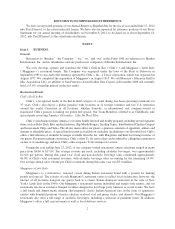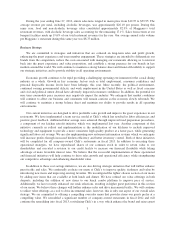Chili's 2012 Annual Report Download - page 20
Download and view the complete annual report
Please find page 20 of the 2012 Chili's annual report below. You can navigate through the pages in the report by either clicking on the pages listed below, or by using the keyword search tool below to find specific information within the annual report.• our ability to achieve projected economic and operating synergies; and
• unanticipated changes in business and economic conditions affecting an acquired business or the
completion of a divestiture.
If we are unable to meet our business strategy plan, our profitability in the future may be adversely
affected.
Our ability to meet our business strategy plan is dependent upon, among other things, our and our
franchisees’ ability to:
• increase gross sales and operating profits at existing restaurants with food and beverage options and
high quality service desired by our guests through successful implementation of strategic initiatives;
• identify adequate sources of capital to fund and finance strategic initiatives, including remodeling of
existing restaurants and new restaurant development;
• identify available, suitable and economically viable locations for new restaurants;
• obtain all required governmental permits (including zoning approvals and liquor licenses) on a timely
basis;
• hire all necessary contractors and subcontractors, obtain construction materials at suitable prices, and
maintain construction schedules; and
• hire and train or retain qualified managers and team members for existing and new restaurants.
The success of our franchisees is important to our future growth.
We have significantly increased the percentage of restaurants owned and operated by our franchisees. While
our franchise agreements are designed to maintain brand consistency, this increase reduces our direct day-to-day
control over these restaurants and may expose us to risks not otherwise encountered if we maintained ownership
and control of same. These risks include franchisee defaults in their obligations to us arising from financial or
other difficulties encountered by them, such as payments to us or maintenance and improvements obligations;
limitations on enforcement of franchise obligations due to bankruptcy or insolvency proceedings; inability to
participate in business strategy changes due to financial constraints; inability to meet rent obligations on leases
on which we retain contingent liability; and failure to comply with food quality and preparation requirements
subjecting us to litigation even when we are not legally liable for a franchisee’s actions or failure to act.
Additionally our international franchisees and joint venture partners are subject to risks not encountered by
our domestic franchisees. These risks include:
• difficulties in achieving consistency of product quality and service as compared to U.S. operations;
• changes to recipes and menu offerings to meet cultural norms;
• challenges to obtain adequate and reliable supplies necessary to provide menu items and maintain food
quality; and
• differences, changes or uncertainties in economic, regulatory, legal, social and political conditions.
Our sales volumes generally decrease in winter months in North America.
Our sales volumes fluctuate seasonally and are generally higher in the summer months and lower in the
winter months, which may cause seasonal fluctuations in our operating results.
12
























